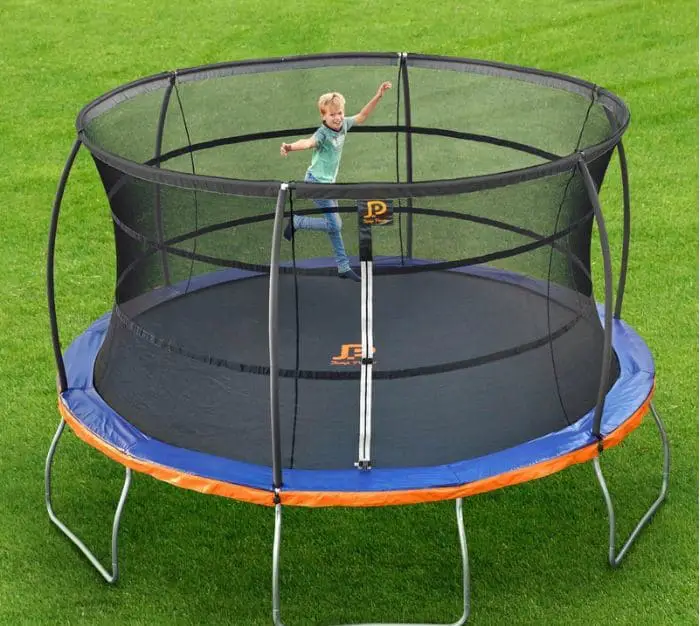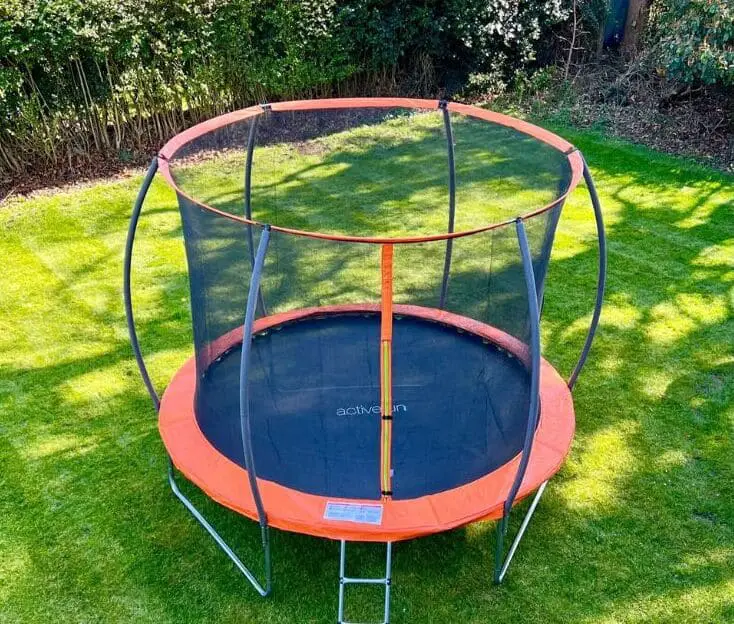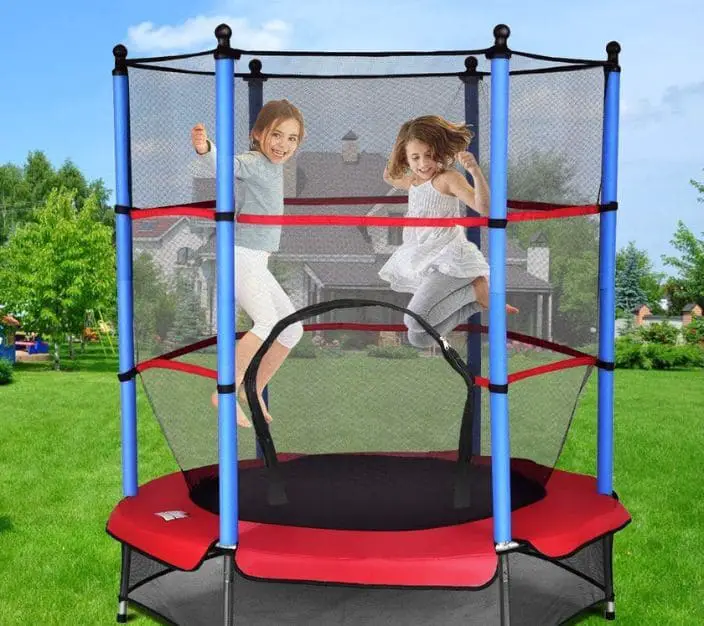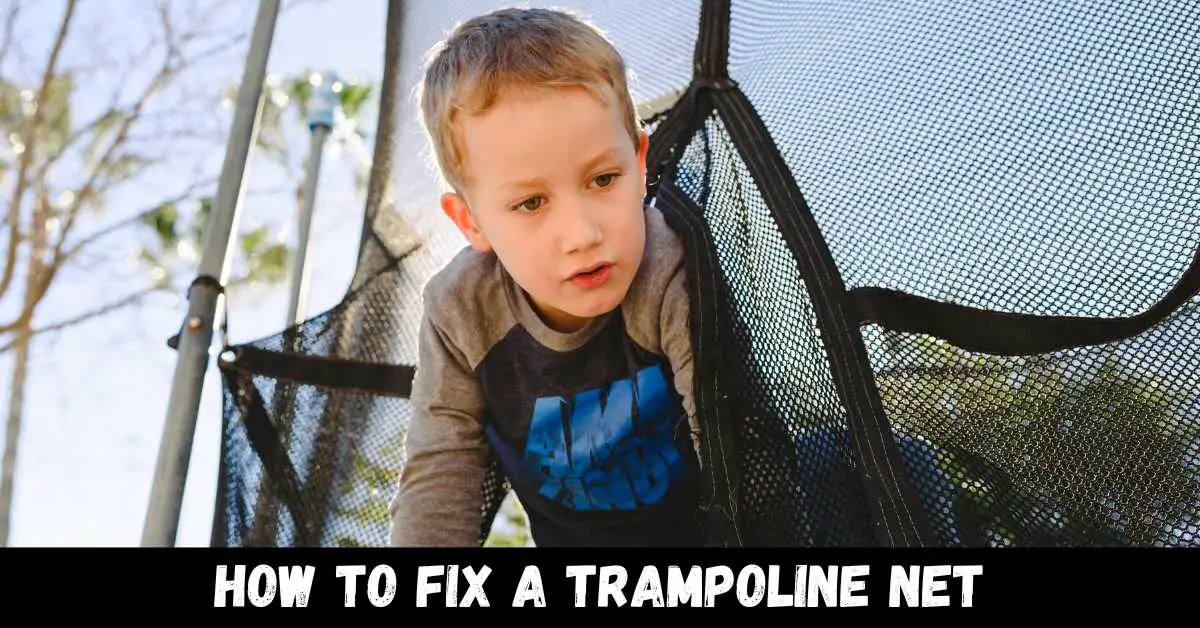I know how important it is to keep my kids active and entertained, but I also understand the safety concerns that come with it. One of the main issues I’ve encountered is the tear or rip in the netting surrounding the trampoline.
It can be frustrating, but I’ve learned that it doesn’t necessarily mean I need to replace the entire trampoline. After all, netting isn’t meant to last forever and will naturally wear out over time with regular use.
To address this issue, I’ve learned how to repair trampoline netting with the right tools and a little bit of time. It’s a process that requires some patience and attention to detail, but it’s doable.
By understanding the steps involved, I can confidently repair any tear and get my family back outside enjoying the trampoline in no time.
I know how important it is to prioritize safety when it comes to trampoline use, so I take the necessary steps to ensure that the netting is in good condition and properly repaired.
With proper maintenance and supervision, my family can continue to enjoy the fun and benefits of trampoline play while minimizing any potential risks.
In this article, we will discuss how to fix a trampoline net.
How to Fix a Trampoline Net: Repair torn trampoline netting with the right tools and a bit of patience. Learn the steps involved in fixing a trampoline net and get your family back outside enjoying it in no time.
How to Fix a Trampoline Net? Short Guide
The safety net for your trampoline is a crucial part of keeping your children safe while they play. It helps prevent accidents like slipping off the trampoline. However, if the safety net is ripped and has a big hole in it, it won’t be effective in keeping your kids safe.
There’s a chance that the safety net of your trampoline might develop a small hole over time. If your kids keep playing on it despite the hole, it could get bigger.
But don’t worry, you can save money by repairing it at home instead of buying a new one, which can cost around $50 or more.
To fix the hole, you just need a big upholstery needle and strong black upholstery thread. Start by sewing the thread into the netting, then zigzag back and forth every half inch along the rip. Keep doing this until the hole is fully repaired, pulling the thread tight as you go.
To prevent the thread from unraveling in the future, tie a knot at the top of the patch. It’s a simple and cost-effective way to repair your trampoline safety net and keep it in good condition for safe play.
Essential Tools for Repairing a Trampoline Safety Net

Make sure you have a toolkit ready for any trampoline repairs or adjustments you may need to make. While some tools are optional, they can be really helpful, especially if you’re working alone.
Here are the tools you’ll need for trampoline repair and maintenance:
- Heavy-duty upholstery thread
- Large upholstery needle
- Fishing line
- Safety gloves (heavy-duty for holding onto spring brackets and thin for reaching into small spaces)
- Wire cutters/strippers
- Needle nose pliers
- L frame tool
- Utility knife with replaceable blades (to cut through the netting and prevent ragged edges)
- Measuring tape (for measuring distances when adjusting components on your trampoline)
Review Your Work:
It’s really important to be careful and thorough when fixing trampoline nets. Take your time and make sure you know what you’re doing. Don’t rush or guess, and if you’re not sure, leave it out.
Once a trampoline net is broken, it can’t be fixed, so make sure everything fits properly before you put any weight on it. Follow these simple steps to repair safely.
Ensure Precise Measurements Before Starting:
- Decide how much of the old net you want to replace and measure the length and width needed.
- Cut the new net about 12 inches longer than needed to have enough for tying off.
- Thread the upholstery thread through the needle and tie a knot on the unused side of the needle’s eye.
- Start on the right side of the trampoline hole and draw the needle through the safety net at the top of the hole.
- Stitch through the safety net from the opposite side, moving about 1.5 centimeters away from the initial rip.
- Keep stitching until you’ve gone through the entire hole.
- Give the thread a firm tug when you reach the end, then create a loop by passing the thread through the safety net again.
- Pass the needle through the loop and pull the thread tightly.
Utilize for Repairing Trampoline Netting:
If you choose to use a fishing line instead of an upholstery thread, start by making a loop and stitching it in the same way as you would with an upholstery thread. Then, when you reach the end, make another loop and tie it off securely.
Cut the Damaged Netting:
- Use scissors to cut out any bad or torn areas of your trampoline net. Only remove the damaged parts, leaving the good parts untouched.
- For small holes or tears, you may only need to trim a small amount of material to cover the damage with a patch.
- For larger tears, you may need to make bigger cuts. Use the appropriate method for cutting your type of trampoline netting.
- You can often reuse pieces from old nets by cutting them down if needed and combining them with new material.
Ensure the Fix is Effective:
- Take your time and be careful when repairing your trampoline net to avoid costly mistakes, such as falling through it.
- Have someone hold down one end of the net while you work on it to prevent accidents.
- Clear away any objects around or on top of your trampoline that could fall on you if bumped into, such as lawn furniture or items stored under an overhang.
- Before jumping on the trampoline, make sure no loose ends are trailing behind you that could get caught in springs or zipper pulls, which could cause injuries.
Importance of Fixing Your Safety Net

There are several reasons why fixing your safety net is better than buying a new one. Replacing a torn safety net can be expensive, costing around $80 or more for larger trampolines. In contrast, patching holes yourself can be done for around $20 at most.
Fixing the safety net is also easier than you might think and can make it look almost brand new. Moreover, minor holes can quickly become major holes, especially if kids see them as a challenge to make them bigger.
By fixing it promptly, you can prevent the issue from getting worse while waiting for a replacement net to arrive. Lastly, it sets a good example for your kids to show that things can be fixed instead of being thrown away, reducing waste in landfills.
Using Upholstery Thread for Repairs
To fix the safety net, you’ll need heavy-duty upholstery thread and a needle. Here’s how you can do it:
- Thread the upholstery thread through the needle’s eye and tie a knot at the other end to prevent it from slipping through the net when pulled tight.
- Start at the right end of the hole and push the needle through the top of the hole, then pull it back through the bottom.
- Move a few inches to the left and repeat this step, going across the hole until you reach the left end.
- Once at the left end, pull the upholstery thread as tight as possible to close the hole.
- Thread the upholstery thread through the net one more time, but this time don’t take it all the way through. Instead, immediately pull the needle through the loop that was made and pull tight. You can do this again for a double knot.
- This will help keep the knot and thread in place, effectively patching the hole in the safety net.
Fixing a sagging safety net?
The safety net may become saggy if there are holes in it, as the holes can cause the net to lose its tightness. Fixing any holes in the safety net should help prevent it from sagging.
Additionally, check the poles that hold up the safety net, as the nuts and bolts on them can become loose over time. Tightening the nuts and bolts can greatly contribute to keeping the safety net tight and in good condition.
How to Put Safety Net on Trampoline: Some Steps
Once you’ve received your trampoline safety net, there are a few things you should do before you start assembling it. Check if your net comes with a warranty and make sure to register it if it does.
Look for an instruction manual or install videos, as some brands may provide them. These resources can help ensure that you install the safety net correctly and make the most of any warranty coverage that may be available.
Here are some steps to put a safety net on a trampoline:
Securely connect the poles to the trampoline frame:
Make sure you have one pole for each leg of your trampoline frame. Some smaller trampolines may have nets that only require one pole for every other leg, which makes it easier for placement and attachment.
Poles can be attached to trampoline legs using a screwdriver, bolts, or clamps, depending on the style of your net. In some cases, you may need to attach the safety net to the poles before attaching them to the trampoline legs, especially if the net slides on top of the poles.
Ensure that you have all the necessary components and materials for assembly:
Assembling your net, make sure you have all the items included in the kit. If you’re missing even one pole, your net won’t work properly.
Also, inspect all the materials for any signs of damage, such as bent poles or tears in the net. It would be frustrating to assemble the entire net only to discover these issues later on.
Put together the safety net:

Make sure to follow the instructions in the user manual to correctly place your net. Look for the doorway, which could be a zipper, clasps, or fabric overlap, and it’s usually located next to the warning label on the bottom of the net.
This means that when you attach the net, you should be able to read the warning label text without it being upside down. If the words are upside down, it’s likely that your net is also upside down.
Assemble any poles that come in multiple pieces:
If your poles are in two pieces, like an upper pole and a lower pole, you’ll need to assemble them separately, similar to setting up a camping tent.
Some poles may come with rubber caps, so make sure to attach them before connecting the poles to the trampoline. Also, if there is foam padding that comes with the poles, be sure to connect it as well.
Check the safety net for any damage or wear before attaching it:
Now that your net is installed, it’s time to test it out and have some fun! Jump around for a few minutes and see if the net stays in place and if it’s snagging on any springs. This is your chance to fix any issues before letting the kids play on the trampoline.
In the following days after installing the net, keep an eye on it to make sure it’s still properly set up. Just like with regular trampoline maintenance, inspect the net regularly for any signs of wear or damage.
Securely attach the safety net to the poles:
There are several ways to attach a safety net to the stability poles. It may sit tightly over the tops of the poles, or it may have straps, clamps, or sleeves that slide down over the poles. Some nets may also have bungee loops or O-rings for attachment.
Repair Process
If you notice minor damage on your trampoline, such as small tears or holes in the net, you can usually repair them using a trampoline repair kit. It’s important to follow the manufacturer’s instructions provided with the repair kit for the specific type of damage you are addressing.
Typically, the repair process involves cleaning the damaged area, applying adhesive or patch material as directed, and allowing it to dry or cure according to the instructions.
In cases where the tears or holes are larger, you may need to reinforce the damaged area with additional patches or use zip ties to secure the netting together for a more effective repair.
It’s important to consider the size and severity of the damage and use appropriate repair methods to ensure a durable and safe repair.
If the attachment points of the net to the trampoline frame are loose or broken, you will need to use the appropriate tools and hardware to reattach or replace them.
This may involve tightening screws or bolts, replacing broken parts, or using additional hardware to reinforce the attachment points.
It’s crucial to ensure that the net is securely attached to the trampoline frame to maintain its safety and effectiveness.
After completing the repair process, it’s important to thoroughly test and inspect the repaired area to ensure it is secure and effective. Check for any remaining damage or weaknesses, and make any necessary adjustments or repairs as needed.
Regularly inspecting and maintaining your trampoline net will help ensure its longevity and continued safety for users.
Final Inspection and Testing
After completing any repairs or maintenance on your trampoline net, it’s important to conduct a final inspection and testing to ensure its safety and effectiveness.
Check for any remaining damage:
Carefully inspect the repaired or replaced areas of the net to ensure that there are no remaining tears, holes, or other damages. Check that all repairs were done according to the manufacturer’s instructions and that the net is in good condition.
Look for any signs of wear or damage that may have been missed during the repair process.
Test the net’s attachment:
Check the attachment points of the net to the trampoline frame to ensure that they are securely fastened. Give the net a gentle tug and check for any looseness or instability.
Make sure that all hardware, such as clasps, straps, or sleeves, are properly attached and provide a secure barrier around the jumping area. If there are any loose or broken attachment points, use appropriate tools and hardware to reattach or replace them.
Test the net’s functionality:
Have a test jump or two on the trampoline to ensure that the repaired net is holding up and functioning properly. Jump around and observe if the net remains in place, without any sagging or shifting, during normal use.
Check that the net effectively prevents users from falling off the trampoline and provides a safe environment for jumping.
If everything looks good and the net passes the final inspection and testing, the trampoline is now ready for use. Always remember to follow proper safety guidelines and manufacturer’s instructions when using the trampoline to ensure the safety of all users.
Regularly inspect the net and perform any necessary repairs or maintenance to keep it in good condition for safe and enjoyable jumping.
Maintenance Tips
To keep your trampoline net in optimal condition and ensure ongoing safety, it’s important to follow regular maintenance practices. Here are some detailed maintenance tips to help you maintain your trampoline net:
Regular Inspection:
Periodically inspect the net for any signs of wear and tear. Check for small tears, holes, loose stitching, or frayed edges. Also, inspect the attachment points of the net to the trampoline frame for any looseness or damage.
If you notice any issues during the inspection, address them promptly to prevent further damage or potential safety hazards. Promptly repairing small tears or holes with a trampoline repair kit can help prevent them from becoming larger issues.
Follow the Manufacturer’s Instructions:
It’s crucial to always refer to the manufacturer’s instructions for your specific trampoline model when it comes to maintenance and repairs. Different trampolines may have different materials, designs, and maintenance requirements.
Following the manufacturer’s guidelines will ensure that you are properly maintaining your trampoline net and not voiding any warranties.
Prompt Repairs:
If you notice any damage to the net, such as larger tears or holes, or if the attachment points are loose or broken, address them promptly. Follow the manufacturer’s instructions or use a trampoline repair kit specifically designed for the type of damage you are addressing.
For larger tears or holes, consider reinforcing the area with additional patches or using zip ties to securely fasten the netting together.
Keep it Clean:
Regularly remove dirt, debris, leaves, and other debris from the net to keep it clean and free from potential obstructions. Use a soft brush or cloth to gently clean the net, avoiding the use of harsh chemicals or abrasive materials that could damage the netting.
Keeping the net clean can help prevent dirt and debris from accumulating and causing damage over time.
Avoid Misuse:
Remind users to follow safety guidelines while using the trampoline, such as not jumping on the net or hanging on it. Avoid any rough play or activities that may cause undue stress or damage to the net.
Educate users about proper trampoline usage, including avoiding overcrowding, using the trampoline only for its intended purpose, and not engaging in dangerous behavior.
Seasonal Maintenance:
Consider implementing seasonal maintenance routines to keep your trampoline net in good condition throughout the year. For example, during winter or times of prolonged disuse, consider storing the net indoors to protect it from harsh weather conditions or other potential damages.
By following these maintenance tips and promptly addressing any issues, you can ensure that your trampoline net remains in good condition, providing a safe and enjoyable jumping experience for everyone.
Regular inspection, prompt repairs, following the manufacturer’s instructions, keeping it clean, avoiding misuse, and implementing seasonal maintenance can all contribute to prolonging the lifespan and safety of your trampoline net.
FAQ’s:
Q:1 How can I fix small tears or holes in my trampoline net?
Small tears or holes in a trampoline net can be repaired using a trampoline repair kit. Follow the manufacturer’s instructions on the repair kit for the specific type of damage being addressed.
Typically, the process involves cleaning the damaged area, applying adhesive or patch material, and allowing it to dry or cure as per instructions. Make sure to thoroughly inspect the repaired area to ensure it is securely in place and there are no remaining issues.
Q:2 What should I do if I have larger tears or holes in my trampoline net?
For larger tears or holes in a trampoline net, it’s recommended to reinforce the area with additional patches or use zip ties to securely fasten the netting together.
Follow the manufacturer’s instructions or use a trampoline repair kit specifically designed for larger tears or holes. It’s important to address larger damage promptly to prevent further damage or potential safety hazards.
Q:3 How can I fix loose or broken attachment points of my trampoline Net to the trampoline frame?
If the attachment points of the trampoline net to the trampoline frame are loose or broken, use appropriate tools and hardware to reattach or replace them.
Follow the manufacturer’s instructions or refer to the trampoline’s user manual for guidance on how to properly reattach or replace attachment points.
Make sure to use suitable hardware and follow proper installation techniques to ensure the net is securely attached to the frame.
Q:4 Can I use any adhesive or patch material to repair my trampoline net?
It’s recommended to use adhesive or patch material specifically designed for trampoline repairs. Avoid using generic or improper materials that may not provide sufficient durability or adherence to the netting.
Always follow the manufacturer’s instructions on the repair kit or adhesive/patch material for the best results.
Q:5 How often should I inspect my trampoline net for maintenance?
It’s recommended to inspect your trampoline net regularly, at least once a month or before each use, for any signs of wear and tear. Additionally, inspect the net after any extreme weather conditions, prolonged disuse, or heavy usage.
Promptly address any issues or damages detected during inspection to prevent further damage or potential safety hazards.
Q:6 Can I perform trampoline net repairs myself, or should I seek professional help?
Minor repairs, such as small tears or holes, can typically be done by following the manufacturer’s instructions and using a trampoline repair kit.
However, if you are unsure about the repair process or if the damage is extensive, it’s recommended to seek professional help from a qualified technician or contact the trampoline manufacturer for assistance.
Q:7 Can I prevent damage to my trampoline net?
While some damages may be inevitable over time, you can take preventive measures to minimize the risk of damage to your trampoline net.
Follow the manufacturer’s instructions for proper usage, avoid overcrowding or rough play on the trampoline, keep the net clean from dirt and debris, and implement regular maintenance routines.
Additionally, educate users about proper trampoline usage and safety guidelines to prevent misuse or risky behavior that may cause damage to the net or other parts of the trampoline.
Conclusion:
In conclusion, fixing a trampoline net requires careful attention to detail and following proper repair techniques. Whether it’s small tears, larger holes, or loose attachment points, using a trampoline repair kit and following the manufacturer’s instructions is key to a successful repair.
It’s important to inspect the net regularly for signs of wear and tear and address any issues promptly to prevent further damage or potential safety hazards.
While minor repairs can be done by the owner, seeking professional help may be necessary for extensive damages or if unsure about the repair process.
By taking preventive measures such as proper usage, regular maintenance, and educating users about safety guidelines, damages to the trampoline net can be minimized.
Ensuring that the repaired net is securely in place, and thoroughly testing the trampoline before use, will help ensure the safety and enjoyment of trampoline activities for years to come.
We hope you will be well aware of how to fix a trampoline net. After reading this comprehensive article. If you have any questions, feel free to comment below!

